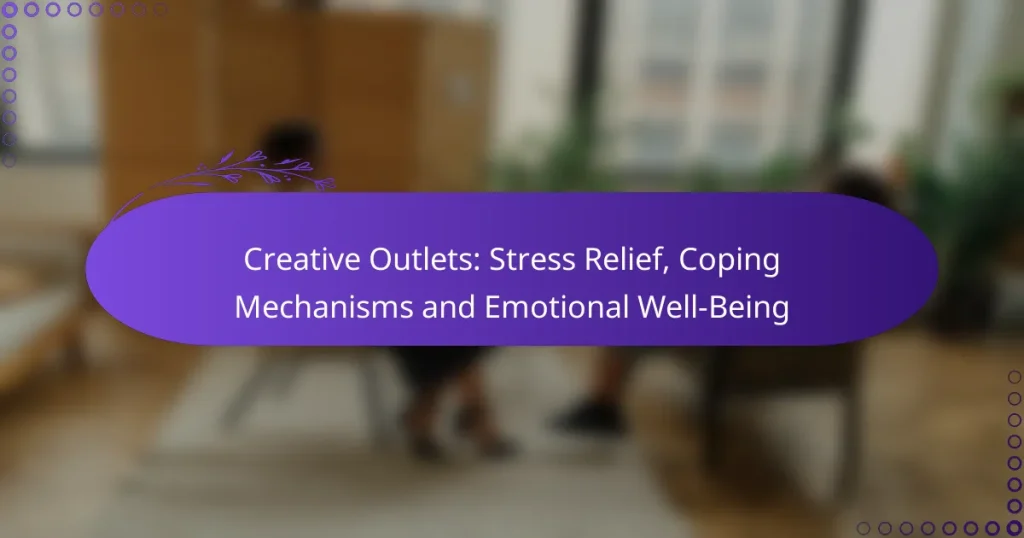Creative outlets serve as powerful tools for stress relief and emotional well-being, particularly in bustling environments like New York City. By engaging in artistic activities, individuals can express their emotions and find solace amidst the chaos, fostering relaxation and resilience. These creative pursuits not only enhance mental clarity but also provide constructive ways to cope with life’s challenges, ultimately promoting a healthier mindset.
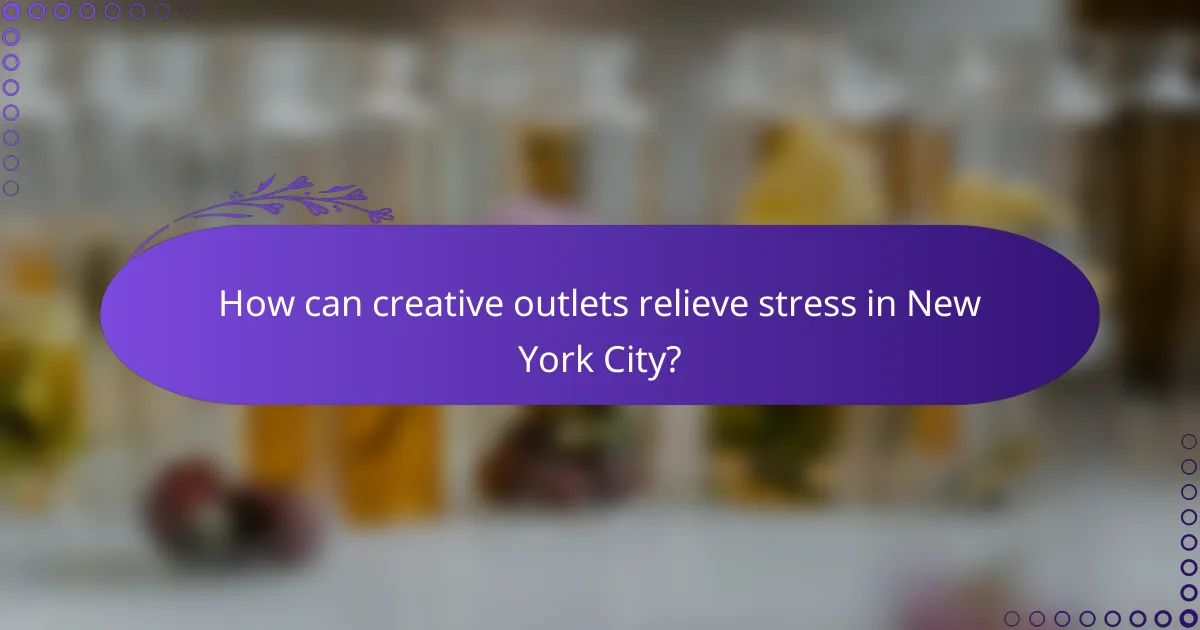
How can creative outlets relieve stress in New York City?
Creative outlets can significantly relieve stress in New York City by providing individuals with a means to express emotions and engage in fulfilling activities. These outlets foster relaxation and emotional well-being, helping residents cope with the fast-paced urban environment.
Art therapy sessions
Art therapy sessions in New York City offer a structured environment where individuals can explore their feelings through various artistic mediums. These sessions are often led by licensed therapists who guide participants in using art as a form of self-expression and healing.
Participants typically engage in activities like painting, drawing, or sculpting, which can help reduce anxiety and improve mood. Many community centers and mental health organizations offer affordable art therapy options, making it accessible for a wide range of individuals.
Community painting workshops
Community painting workshops provide a relaxed setting for New Yorkers to unwind and connect with others while creating art. These workshops often focus on specific themes or techniques, allowing participants to learn new skills while enjoying a social atmosphere.
Local studios and galleries frequently host these workshops, with fees generally ranging from $20 to $50 per session. They can be a great way to meet new people and share experiences, enhancing emotional well-being through creativity.
Music classes for relaxation
Music classes in New York City can serve as a powerful tool for relaxation and stress relief. Whether it’s learning to play an instrument or participating in group singing, these classes encourage participants to immerse themselves in music, which can be therapeutic.
Many community centers and music schools offer classes tailored for all skill levels, with costs typically between $15 and $30 per session. Engaging with music not only fosters creativity but also promotes a sense of community and connection among participants.
Writing groups for emotional expression
Writing groups in New York City provide a supportive environment for individuals to express their thoughts and feelings through the written word. These groups often focus on various genres, including poetry, fiction, and personal essays, allowing participants to explore their emotions creatively.
Many local libraries and community centers host writing workshops, often free or at a low cost. Joining a writing group can help individuals process their experiences, gain feedback, and build a sense of belonging, all of which contribute to improved emotional well-being.
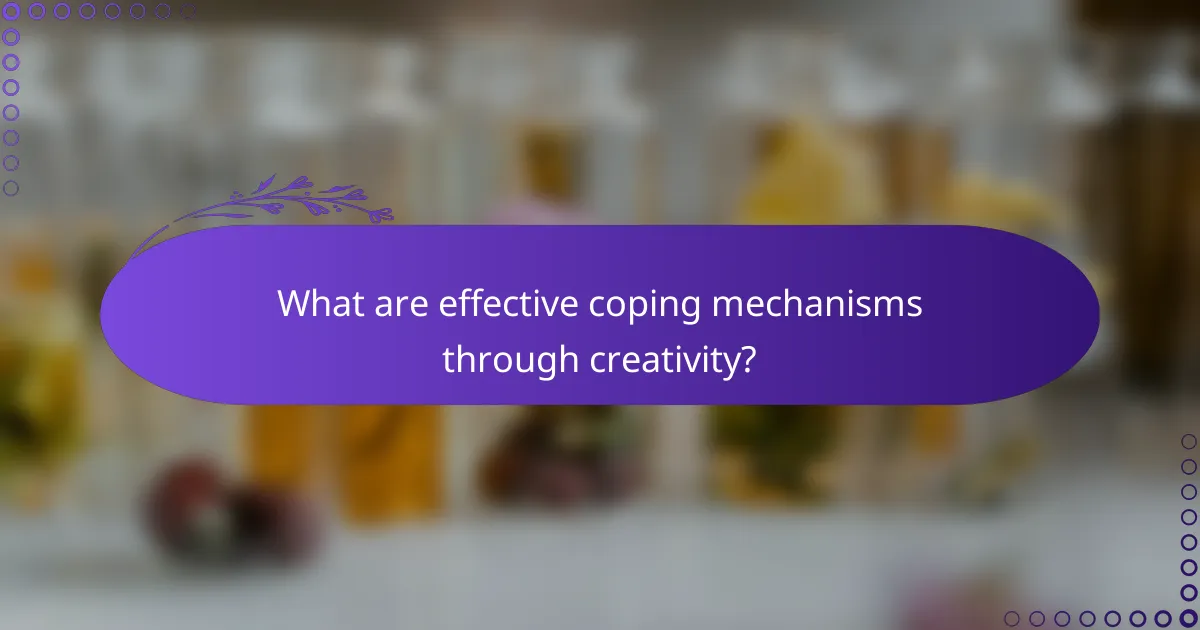
What are effective coping mechanisms through creativity?
Effective coping mechanisms through creativity include various activities that promote emotional expression and mental clarity. Engaging in creative outlets can significantly reduce stress and enhance overall well-being by providing a constructive way to process feelings and experiences.
Journaling for self-reflection
Journaling serves as a powerful tool for self-reflection, allowing individuals to articulate their thoughts and emotions. By writing regularly, you can gain insights into your feelings and identify patterns that may contribute to stress or anxiety.
To start journaling, set aside a few minutes each day to write freely about your experiences, thoughts, or feelings. Consider using prompts like “What am I grateful for today?” or “What challenges did I face this week?” to guide your reflections.
Crafting as a mindfulness practice
Crafting can be an effective mindfulness practice that encourages focus and creativity. Activities like knitting, painting, or sculpting allow you to immerse yourself in the present moment, reducing anxiety and promoting relaxation.
Choose a craft that interests you and dedicate time each week to engage in it. Keep your workspace organized and free from distractions to enhance your focus. Remember, the process is more important than the final product—enjoy the journey of creating.
Dance therapy for emotional release
Dance therapy provides a unique avenue for emotional release, combining movement with expression. This form of therapy allows individuals to explore their feelings through physical activity, which can lead to improved mood and reduced tension.
To incorporate dance therapy into your routine, consider joining a local class or simply dancing at home to your favorite music. Focus on letting go of inhibitions and expressing yourself freely, as this can foster a sense of liberation and joy.

How does creativity enhance emotional well-being?
Creativity significantly boosts emotional well-being by providing an outlet for self-expression and stress relief. Engaging in creative activities allows individuals to process their emotions, leading to improved mental health and resilience.
Boosts self-esteem through artistic expression
Artistic expression is a powerful tool for enhancing self-esteem. When individuals create something unique, whether it’s painting, writing, or crafting, they experience a sense of accomplishment that reinforces their self-worth.
Participating in creative activities can help individuals recognize their talents and abilities, fostering a positive self-image. Simple projects, like completing a scrapbook or writing a poem, can provide immediate boosts in confidence.
Fosters social connections in group activities
Creative group activities, such as community art classes or theater groups, promote social interaction and bonding. These environments encourage collaboration and communication, helping individuals build friendships and support networks.
Joining a local art club or participating in workshops can enhance feelings of belonging and reduce feelings of isolation. Engaging with others who share similar interests creates a sense of community that is vital for emotional health.
Encourages positive thinking and resilience
Creativity promotes positive thinking by allowing individuals to explore new perspectives and solutions. Engaging in creative processes can shift focus from negative thoughts to constructive ideas, fostering a more optimistic outlook.
Moreover, creative activities can serve as coping mechanisms during challenging times. For instance, journaling or painting can help individuals process their feelings, leading to greater emotional resilience and the ability to bounce back from adversity.
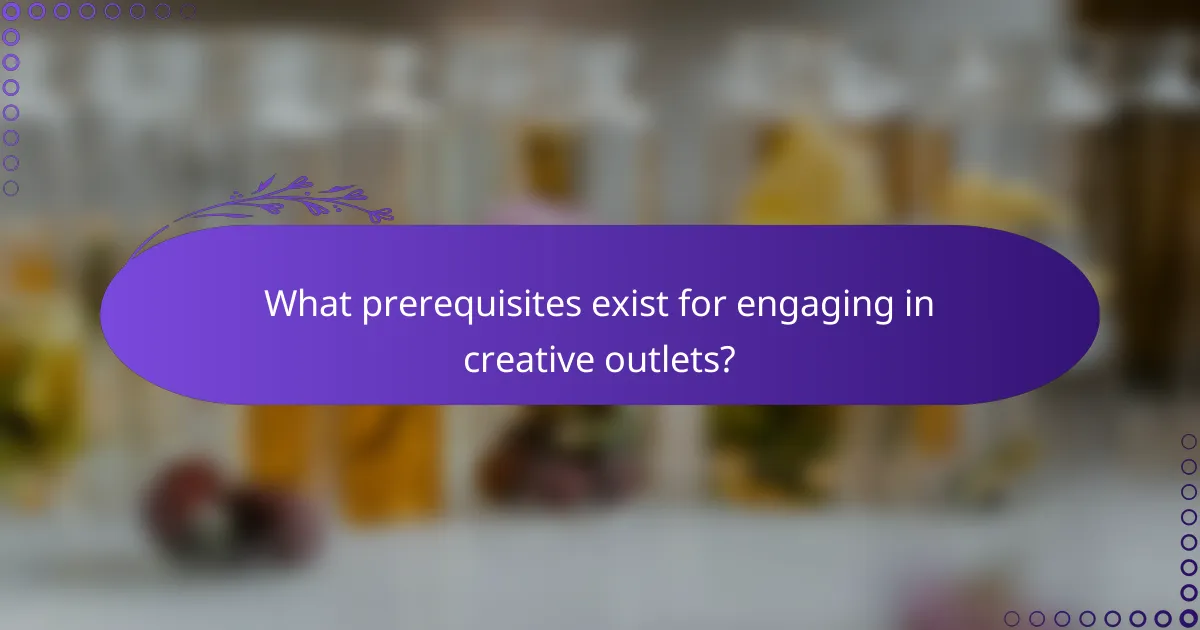
What prerequisites exist for engaging in creative outlets?
Engaging in creative outlets often requires certain prerequisites that can enhance the experience and effectiveness of these activities. Key factors include access to necessary materials, availability of supportive community resources, and a commitment of time for participation in classes or workshops.
Access to local art supplies
Having access to local art supplies is crucial for anyone looking to engage in creative activities. This can include paints, brushes, canvas, or crafting materials, which can often be found at local art stores or online retailers. Consider visiting community shops or markets that may offer unique, locally sourced supplies.
When selecting art supplies, prioritize quality over quantity. Investing in a few high-quality items can significantly enhance your creative output. Look for sales or discounts, as many stores offer seasonal promotions that can make purchasing supplies more affordable.
Availability of community centers
Community centers play a vital role in providing spaces for creative expression. They often host workshops, classes, and events that cater to various artistic interests, from painting to pottery. Check local listings to find out what programs are available in your area.
Participating in community center activities can also foster connections with like-minded individuals, creating a supportive network that encourages creativity. Many centers offer free or low-cost options, making them accessible to a wider audience.
Time commitment for classes or workshops
Time commitment is an important consideration when engaging in creative outlets. Classes or workshops can vary in duration, typically ranging from a few hours to several weeks. Assess your schedule to determine how much time you can realistically dedicate to these activities.
Be mindful of balancing your creative pursuits with other responsibilities. Setting aside specific times each week for creative activities can help ensure consistency and progress. If you find a class that fits your schedule, it can provide structure and motivation to enhance your skills.
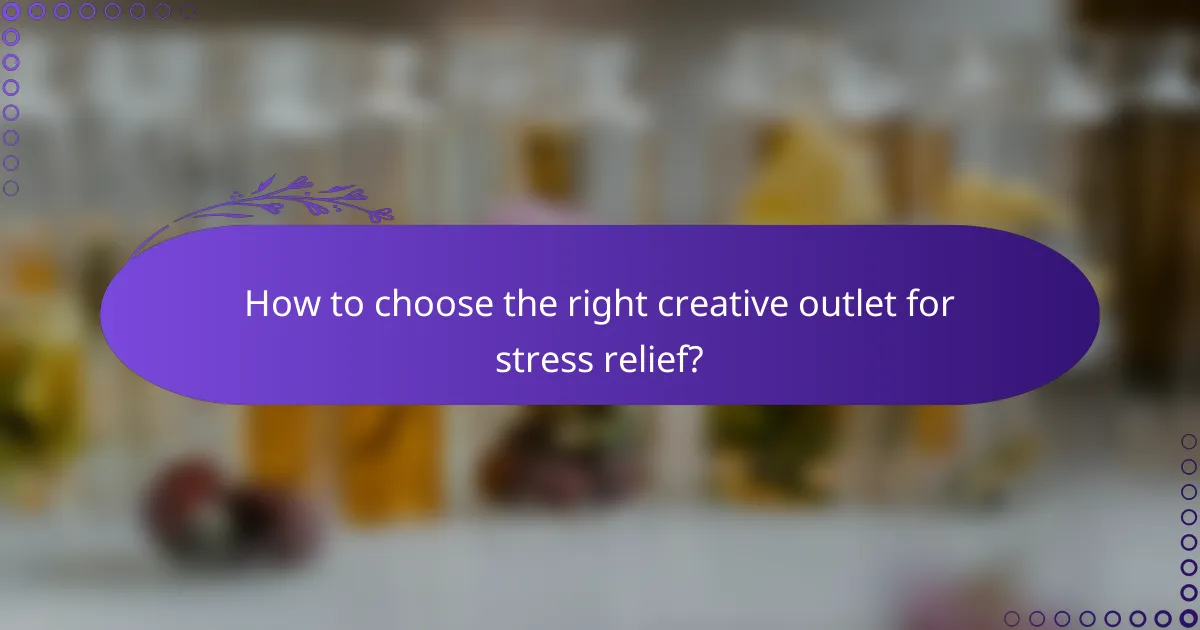
How to choose the right creative outlet for stress relief?
Choosing the right creative outlet for stress relief involves identifying activities that resonate with your interests and fit your lifestyle. Consider what you enjoy, how much time you can dedicate, and whether you prefer working alone or with others.
Assess personal interests and skills
Start by reflecting on your hobbies and skills. Think about what activities you have enjoyed in the past, whether it’s painting, writing, or playing music. Engaging in something you are passionate about can enhance your experience and provide greater stress relief.
Additionally, consider your skill level. If you are a beginner, choose an outlet that allows for growth without overwhelming pressure. For example, joining a beginner’s art class can be a great way to explore painting while developing your skills.
Consider group vs. solo activities
Decide whether you prefer creative outlets that involve collaboration or those that allow for solitude. Group activities, such as dance classes or community theater, can foster social connections and provide support, which may enhance emotional well-being.
On the other hand, solo activities like journaling or crafting can offer a peaceful escape and allow for deep personal reflection. Weigh the benefits of each type based on your personality and current emotional needs.
Evaluate time and budget constraints
Assess how much time you can realistically dedicate to a creative outlet. If you have a busy schedule, consider activities that require less time commitment, such as short writing prompts or quick sketches. Aim for consistency, even if it’s just a few minutes each day.
Budget is another important factor. Some creative outlets can be expensive, while others require minimal investment. For example, starting a garden may involve initial costs for seeds and tools, while drawing only requires paper and pencils. Choose an outlet that fits your financial situation to avoid added stress.
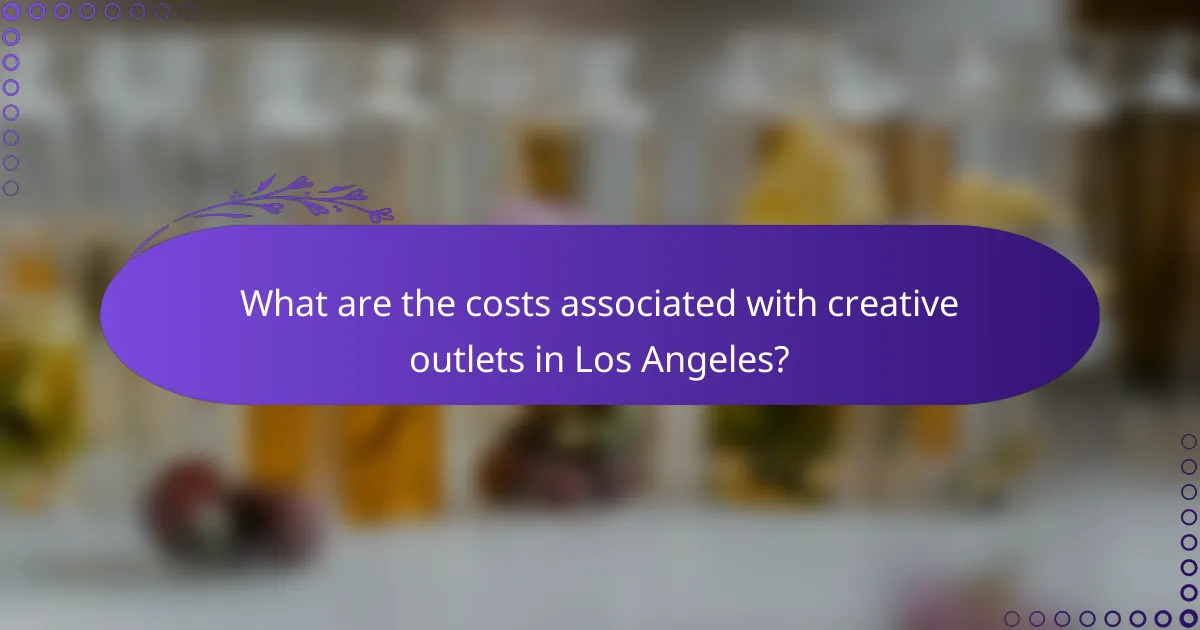
What are the costs associated with creative outlets in Los Angeles?
In Los Angeles, the costs associated with creative outlets can vary widely based on the type of activity and the resources involved. Whether you are interested in art classes or DIY projects, budgeting for these expenses is essential for making the most of your creative pursuits.
Average fees for art classes
Art class fees in Los Angeles typically range from around $20 to $100 per session, depending on the instructor’s experience and the class duration. Group classes tend to be more affordable, while private lessons can be significantly more expensive.
Many community centers and local art schools offer discounted rates for longer courses or package deals. It’s advisable to compare options and look for introductory offers to minimize costs while exploring different artistic styles.
Costs of materials for DIY projects
The costs of materials for DIY projects can vary greatly based on the complexity of the project and the quality of materials chosen. Basic supplies like paints, brushes, and canvases can start at around $30 for a beginner’s set, while more specialized materials may cost significantly more.
To keep expenses manageable, consider sourcing materials from local craft stores or online retailers that offer bulk discounts. Always check for sales or coupons, as many stores frequently run promotions that can help reduce your overall spending on DIY projects.
